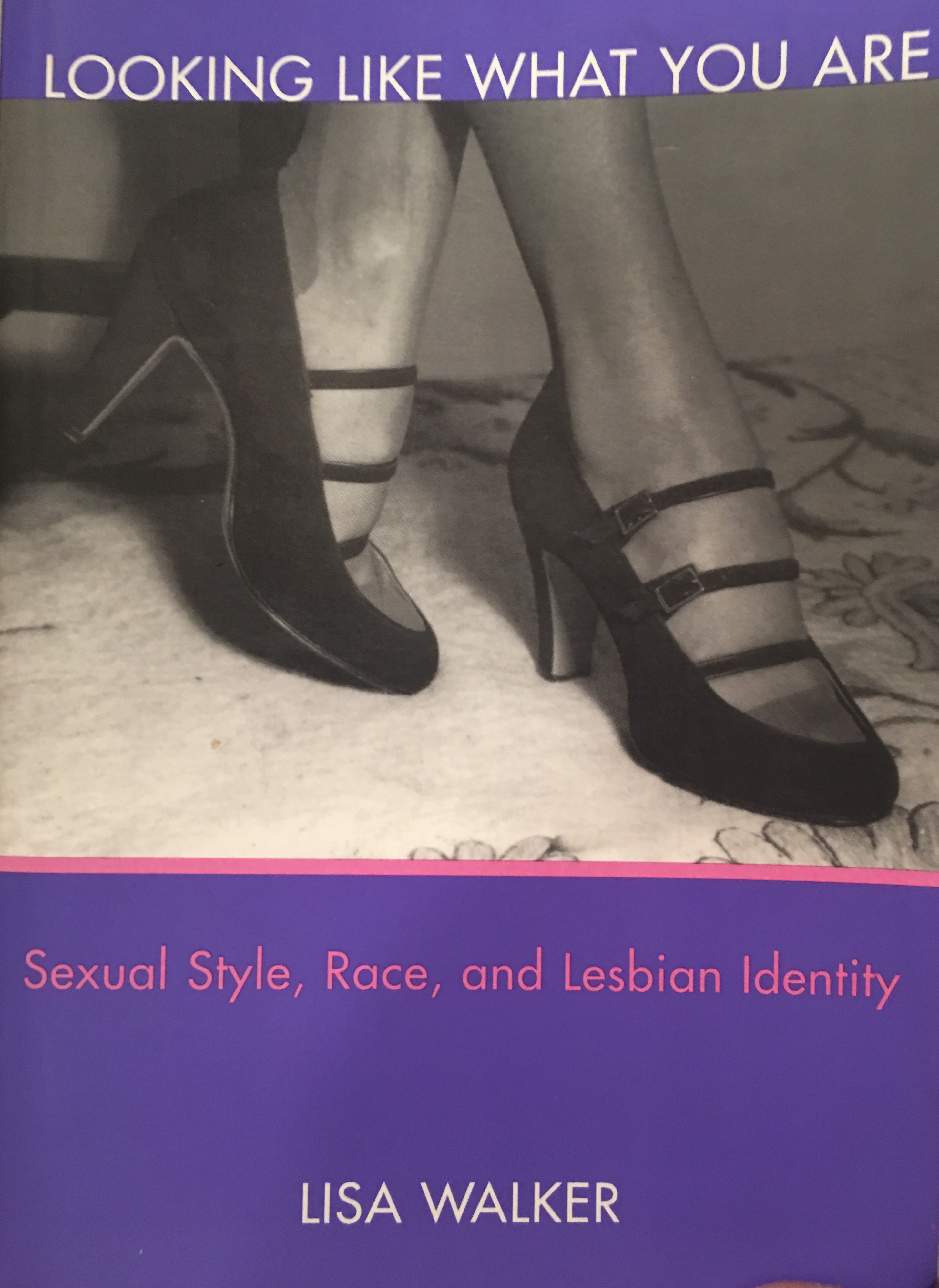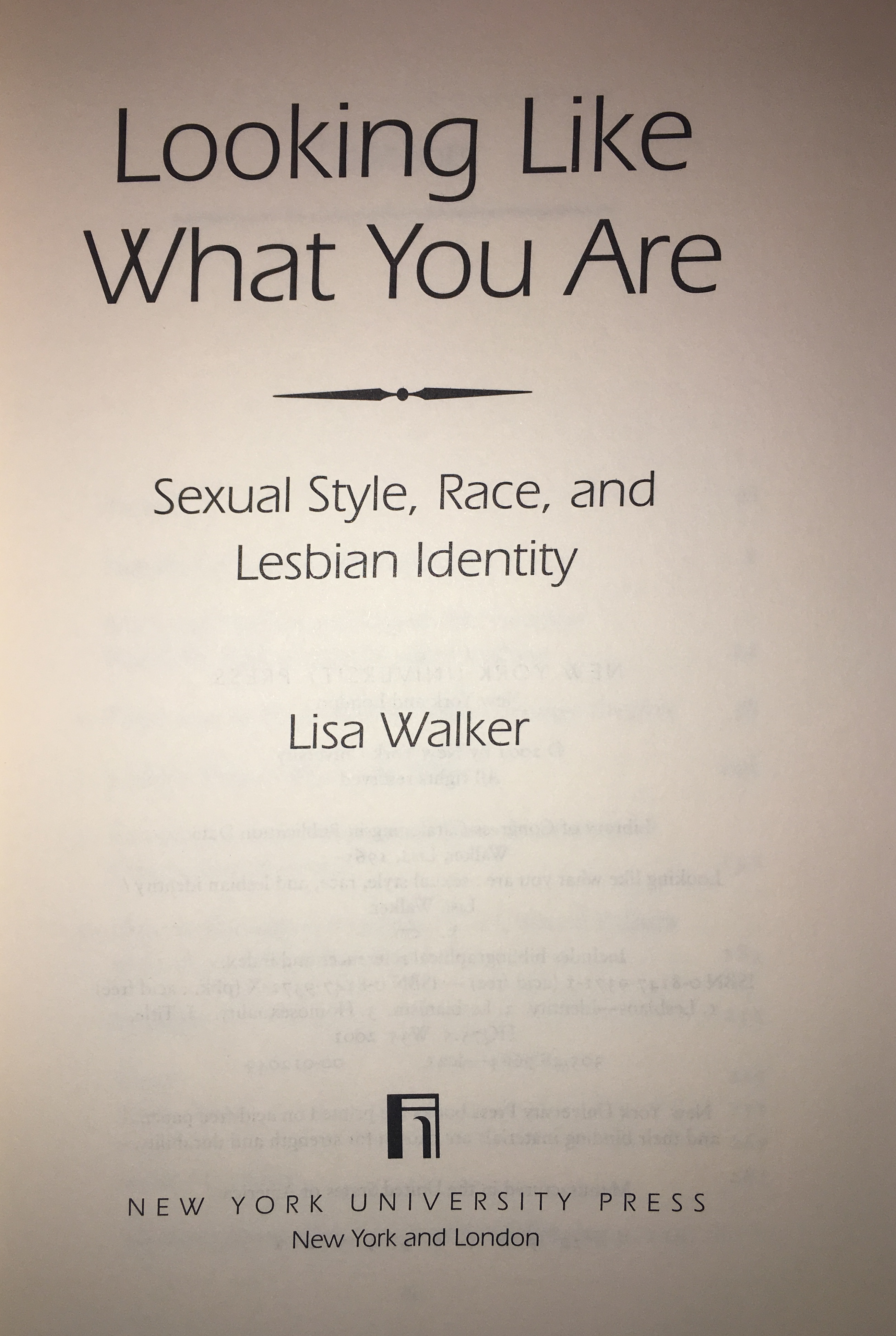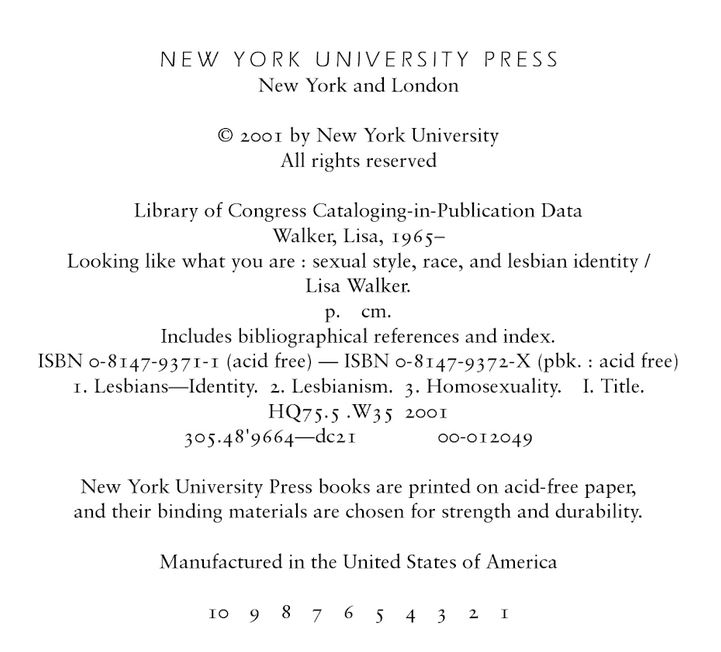
Lisa Walker.
“Lesbian Spotting in Baton Rouge, 1988.”
© Lisa Walker.
Used by permission.
All rights reserved.



The Anecdote
I was initiated into the intricacies of lesbian sexual style when my first lover, ML (butch for Mary Lou), announced that there was such a thing as a “lipstick lesbian” and that I probably was not the only one even though she could not acquaint me with any peers. It was at a New Year's Eve party at which I had met her friends from the rugby team. As she requested, I wore my Christmas present from her, a vintage sweater that had belonged to her grandmother, cashmere with a mink collar and pearl clasps. I was the only one there not dressed in flannel and jeans, except for ML, who had generously agreed to don a gold lame shirt to make me feel less out of place. I sensed that her teammates were skeptical about me when I was introduced. They smiled quickly, shook my hand, and broke off into pairs and trios with their drinks. I mingled long enough to be informed which of the guests were ML’s exlovers. The ice did not really break until someone suggested we play a word game. Everyone took seats and formed a circle. I chose an armchair and ML sat at my feet. In the middle of someone else’s turn, ML turned and lifted the hem of my long swishy skirt to peek underneath. I smiled and lightly popped her on the head, and the rest of the women burst into laughter.
The gesture both marked and recuperated my difference in a way that eased the mistrust of women whose codes of recognition did not include the sexual style “femme” but did acknowledge, if not overtly then tacitly, the sexual style “butch” — or at least the eighties version of it, the ubiquitous flannel-shirts-and-jeans lesbian drag. I’m still not sure exactly what made the gesture work to that effect. It plays on the heterosexual oedipal scenario in which anatomical difference figures sexual difference and then reduces it to an instance of visible perception (the little boy looking up the little girl’s dress). But between women, the peeking signifies not sexual difference (assumed to be anatomical difference), but differences of gender/ sexual identity within the category “female,” so that it becomes a joke about sameness as much as difference. Perhaps the emphasis on sameness alleviates the discomfort about differences in sexual style that initially created suspicion. It may also be that the action, initiated by a butch woman, marks the femme as the object of sexual interest in a way that includes her in a community where she is not accepted at face value.
I begin with this anecdote as a way of situating myself in relation to the issues of visibility that interest me. It is the sensation of being invisible as a lesbian in a community where, as commentator on lesbian culture Pat Califia puts it, “butches think of femmes as straight girls taking a sapphic vacation from serving the patriarchy” (10) that prompted me to think about the construction of identities through the trope of visibility. Privileging visibility has become a tactic of late twentieth-century identity politics, which often symbolize their demands for social justice by celebrating visible signifiers of difference that have historically targeted them for discrimination. For example, the lesbian and gay community gives symbolic power to cross-dressing as a signifier of homosexuality by selecting a drag queen to be “Miss Gay Pride” for the annual June Pride march and sending her down Fifth Avenue in a convertible. Similarly, the Black Power Movement’s slogan “Black is Beautiful” gives symbolic value to skin color and ethnic styles as signifiers of racial difference by reversing Eurocentric definitions of beauty.
This privileging of the visible plays on what Marjorie Garber describes as the “hegemonic cultural imaginary’s” desire to see and interpret otherness in order to “guard against a difference that might otherwise put the identity of one’s own position into question” (130). Based on such analysis, feminist and lesbian and gay theorists have begun to theorize the performance of visible differences as the locus of political agency because of its potential to deconstruct foundational categories of identity such as race, gender, and desire.

Introduction
Writing an academic book is a strange project. When people who do not work in the academy hear that I am writing a book, they usually think it is a novel. When I explain that it is not a novel, but a book about books, they look at me as if to say, “Why would anybody want to do that?” I often evade the issue by saying that I have to do it to keep my job. But the truth is that we are much more invested in our books than that. As soon as my parents’ best friends or my students or my colleagues or someone I have just been introduced to at a party asks what the book is about, I am being called on to reveal my personal investment in my writing. Some writers’ investments are less apparent than others’. Mine are obvious. I can recall the very incident that determined the focus of my research.
I have to thank the exterminator at the Villa Rose apartments in Baton Rouge for the origins of this project. In Louisiana, you never have to be reminded that insects outnumber people on this planet by a ratio of millions to one. So the exterminator came regularly to keep the bug population manageable. The exterminator was a lesbian. I knew she was, because of “gaydar,” because of the way she wore her hair and her jeans, because of the way she walked, because of all the ways one lesbian will recogize another — sometimes, anyway, because she was not so sure about me.
I was often home getting dressed to teach or attend class when she came to exterminate. For me, getting dressed always means getting dressed like a girl. The exterminator saw me iron skirts, apply lipstick, and slip into pumps before I flew out the door running late. But even in my haste, I tried to communicate with her through “the look” — the one that says “I know what you are because I am one too.” We never spoke much beyond greeting each other. Sometimes I left before she had finished her work. Apparently it was on these days that she perused the apartment for clues about my sexuality. I know that she did because once, when my girlfriend Catherine from Philadelphia was visiting, the exterminator came while I was at school, and they spoke. The exterminator spoke to Catherine because she recognized her as a lesbian. She began the conversation in a roundabout way, dropping a few broad hints the way Southerners will. When Catherine mentioned the name of the local women’s bar, the exterminator corrected her etiquette: “You’re not supposed to ask if I know that bar.” The question was too direct.
But at some point the exterminator got very direct about her reading of the clues in my apartment. They were, conincidentally, in the bedroom. I decorated on a graduate student budget, but I always decorated. A huge foor-to-ceiling poster of Madonna took up one wall of the room. As far as posters of Madonna go, it was good: a sepia-toned photograph of the star dripping in the pearls, lace, and crucifixes of her 1980s look. She gazed at herself in the mirror of a vanity strewn with more extravagant accessories. I had hung my windows with lace curains that echoed the patterns of Madonna’s lingerie. On another wall was a series of black-and-white fashion photos from a French magazine, all of the same dark-haired woman, looking terrifically stylish posing at a café table in a hat with a net veil over her eyes, holding a cigarette in one hand and an espresso in the other. The numerous images of women in the room struck the graduate students who helped me move in the heavier furniture from storage as odd. They asked if I knew the model in the photo, and when I said no, they asked why I had put them up. I said, “I think she’s beautiful, don’t you?” That answer did not register with their expectations; they looked confused and changed the topic of conversation.
But those very images must have registered with the exterminator. Catherine’s presence in the apartment, clearly as an extended visitor, and the fact that I had only one double bed, confirmed a suspicion that the photos had apparently sparked months ago — she had guessed that I might be a lesbian after all. Catherine had a long chat with the exterminator about the lesbian communities in Baton Rouge and Philadelphia. I heard all about it when I came home. Listening to Catherine, I found myself a bit put out that this woman, whom I had greeted regularly at the beginning of every month, had never really spoken to me, but had taken Catherine into her confidence at first sight.
Catherine tried to explain. It made sense, she said, that the exterminator, who was clearly a lesbian, should speak to her, as she was clearly a lesbian, and not to me, who was not clearly a lesbian. I listened longer to Catherine talking about how there was a bond between women who were visibly queer, and that the exterminator, despite her inferences, could not rightly be expected to feel safe talking to someone who was not so visible, who could pass for straight, and who might be straight, after all. “The look” was not proof enough. The decor was not proof enough. Only the presence of Catherine, who was readable as butch by anyone in the know, could confirm that I was a lesbian. And besides, Catherine went on, femmes did not bear the weight of the homophobia directed against lesbians; they were not under the same kind of scrutiny and assault by the heterosexual world, and so that easy recognition and trust between the most visibly stigmatized members of the community was natural.
Putting aside that the exterminator was your jock type, not your butch type, and could have just as easily been a straight softball player as a lesbian, I gave this some thought. It was true that I was not called a dyke on the street like Catherine was. It was true that the evangelists on campus did not scream “Sodomite!” when I walked by the way they did when my friend Scott walked by in those nerdy-chic outfits that only the gay boys wore.
But then I thought back to the previous year, when I was with my first lover, ML. I remembered dancing with her in a straight bar, foolishly ignoring the rules for personal safety in a homophobic culture. When the bar closed, there was a group of young men outside waiting for us. “You,” they said, pointing to where I stood in a checked mini and heels, “don’t look like one.” They dismissed me in an instant. I was not a real lesbian, probably just led astray, surely redeemable, all I needed was … “But you,” they said, pointing to where ML stood in her jeans and button-down shirt, “we know what you are.”
They wanted to beat her up, and she did not want to back down in front of me or the twenty or thirty people who lined the wall outside the bar watching. The boys goaded her, making conjectures about what we did in bed in graphic and vulgar language. I had never felt so violated before, not when I heard the word “cunt” hissed in my eat on the street, not when a man had followed me from one subway train to the next for the pure pleasure of watching my anger and anxiety heighten, not when another put his hand between my legs while I stood in line to buy a token. I remembered walking up to ML, who was moving into the tightening circle of boys, preparing to defend our honor. I took hold of her belt and led her out of that circle while I told her, loud enough for the boys to hear, that they were ignorant trash unworthy of any response whatsoever. Holding myself above it all had always been an easy way out of a fight, and it worked again this time. The boys left and the watching crowd began to mumble about how obnoxious they had been. I mentally thanked them for their support during the confrontation; they would have stood there and watched one woman get beat up by a half a dozen obnoxious boys.
ML was devastated, sure that the incident would scare me away from lesbianism, sure that she had not made the world seem safe enough for me to be out in. Why she thought that particular encounter with men would turn me straight never has made sense to me, but butch girls do have their own logic when it comes to femmes. They often regard us as liable to run from “the life” into the sheltering arms of normalcy at any minute. Out of this anxiety about the femme’s identity, loyalty, and ability to endure, other lesbians sometimes reject back to me just what those boys assumed when they dismissed me and turned all their hatred toward ML — that because I did not look like a lesbian I must not really be one. Maybe that anxiety can explain the times I have walked into a lesbian bar alone, without the benefit of a butch beside me, and never been spoken to or asked to dance by anyone but straight men offering to help clear up any doubts I might have about my sexuality.
Listening to Catherine and remembering, I became angry with my own community. It was not that I thought Catherine was wrong. I agreed that I do not often bear the brunt of verbally abusive and physically threatening homophobia except when I am with other women who look lesbian, or with them in a way that looks lesbian. If I am mistaken for straight, I can choose not to correct the assumption, so I do not know Catherine’s experience of being constantly under surveillance. For her, this meant that being a lesbian who looked like me was easier, because I could pass. On one level this makes sense to me. Passing can be a convenience, and not all of us have access to that convenience. But on another level, I ask myself for whom is it easier that I look the way I do? It may be easier for a relative or two. If there has to be a lesbian in the family, at least she looks like a regular girl. It may be easier for some of my colleagues and some of my students, because a femme can seem less threatening, less different than a butch. And yes, it may be easier for me when I walk down the street, when I go to the store, when I go to the “ladies’” room. No one ever calls me “Sir,” no one ever looks at me like I’m in the wrong department when I shop for clothes, and no one ever screams or orders me to leave when I enter a public bathroom.
On the other hand, I told Catherine, you do not know what it feels like to be shut out of your own community, to be regarded with suspicion where you most need to be accepted. You do not know what it feels like to have other lesbians assume that you are straight, or even if they know better, to assume that you are not as real, to assume that at any minute you might turn “traitor” and leave your woman for a man; to assume that you are not strong and could not possibly be smart because you paint your nails instead of playing softball. What lesbians assume about me is more important than what straight people assume. And when other lesbians assume that I am less than they are because of the way I look, they devalue me.
After the exterminator incident, I decided two things: First, that I would cling to my heels and my nail polish and not be deprived of my pleasure in all things high-femme because of anyone else’s expectations about what a real lesbian looks like. And second, that I would write about how lesbianism came to be defined in a way that marginalized femmes. I begin with this anecdote as a way of situating myself in relation to the issues of visibility that interest me. It is the sensation of being invisible as a lesbian in a community where, as Pat Califia puts it so well, “butches think of femmes as straight girls taking a Sapphic vacation from serving the patriarchy,” that prompted me to think about the construction of identities through the trope of visibility.
Text prepared by:
- Bruce R. Magee
Source
Walker, Lisa. “Preface.” Looking like what You Are: Sexual Style, Race, and Lesbian Identity. New York: New York University Press, 2001. xi-xvii. Google Books. Web. 17 July 2018. <http://books. google.com/ books?id= NyUUCgAAQBAJ>. © Lisa Walker. Used by permission. All rights reserved.
